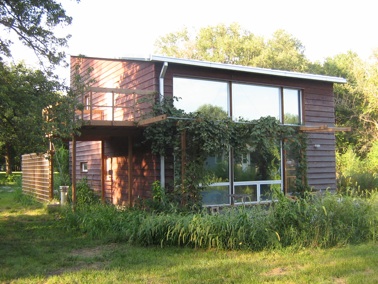For the past couple of months, my husband Mike Knezovich has had two full-time jobs. He rose to the occasion after I broke my foot in June, walking Harper, accompanying me to doctor appointments, chauffeuring me to the Chicago Cultural Center so I could teach my memoir classes, running all our many, many errands. He helped me sort through the heartwrenching decision to retire Harper early, and once that decision was made he shepherded me to France to meet up with dear friends. Well, I guess that last part wasn’t really work.
Through all that, Mike was keeping up with his day job for Passive House Institute US (PHIUS), flying to DC to visit potential sites for their annual conference, working with vendors and exhibitors, promoting the event and juggling–with his coworkers–all other sundry things involved with planning a national conference. And now, the Passive House conference is here! It starts this week, and this article in USA Today helps explain what PHIUS is all about:
The passive house movement, popularized in Europe, where thousands of such homes have been built, is starting to catch on in the United States as consumers look to lower their utility bills. These homes don’t require pricey solar panels or wind turbines but focus on old-fashioned building science to reduce energy use by up to 90% less energy. They’re different from the “passive solar” homes of the 1970s, which used a lot of south-facing windows for heating, because they emphasize other features: thick walls and roofs (often at least a foot) and triple-paned windows, as well as efficient appliances and lighting. The secret is tightness, achieved via superior insulation and air sealing. A mechanical system brings in fresh air, heating or cooling it as needed.
Few U.S. homes, only a dozen so far, have obtained certification from the Passive House Institute US, a private Illinois-based group that bases its rules on the German Passivhaus standard.
Well, the number of certified homes is up to 24 now, with dozens more–including commercial buildings–in the pipeline. PHIUS is working to make passive house commonplace in new construction and retrofitted buildings.
When I tell friends about Mike’s work with passive houses, their first question is almost always about the windows. “So you have to keep the windows closed all the time?” The answer is no. When the weather is nice outside, you can still open the windows. But when temperatures are outside the range where you’d be comfortable with the windows open, the idea is to keep the inside of the home comfortable all year long, and the super-insulation means most passive homes don’t need a conventional furnace. The ventilator runs constantly at very low, quiet levels to provide air quality. And the windows–triple-paned in most cases–mean you can sit by one and never know it’s below freezing outside.
Katrin Klingenberg’s Smith House, completed in Urbana, Ill. in 2002, was the very first Passive House built in the United States. Which is appropriate, because fundamental passive house principles were actually developed at the University of Illinois back in the 70s. Builder Mike Kernagis pitched in on other Passive House projects that were built as affordable housing in partnership with the City of Urbana, and in 2007 Klingenberg and Kernagis founded Passive House Institute US (PHIUS). Since then more Passive House structures have been built in the United States, and more are in the works. And PHIUS has certified more than 200 architects, engineers and builders as Certified Passive House Consultants. You can find consultants here.
The PHIUS conference will take place in Silver Spring, Maryland and includes tours of existing passive house projects and a ton of practical , academic and hands-on advice on how to design and build to the passive house standard–and even a panel of folks who live in these things. You can link here to view the conference’s full schedule, including passive house building tours and pre-conference workshops. You can still sign up for the conference online, but you’d better do it fast — registration closes Tomorrow night, October 23.
And hey, if you go to the conference and you see Mike Knezovich there, do me a favor: pat him on the back for two jobs well done.

I can’t make it to the conference, but thank you for posting the links here. Very interesting.
Interesting to hear these houses were built as affordable housing somewhere. Makes sense!
That Mike deserves a lot of credit and more than one pat on the back! Very impressive stuff. You two are just amazing….no wonder you met and are wonderful together.
Leave a Response